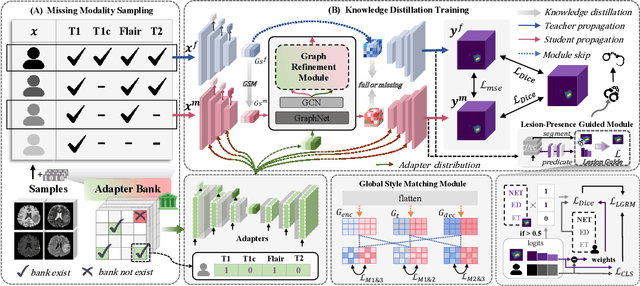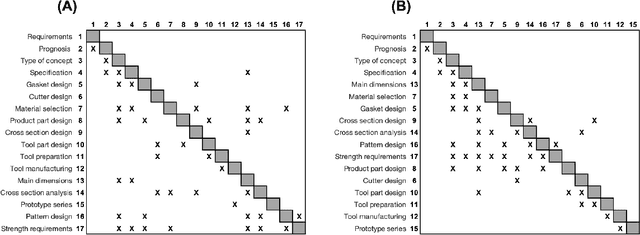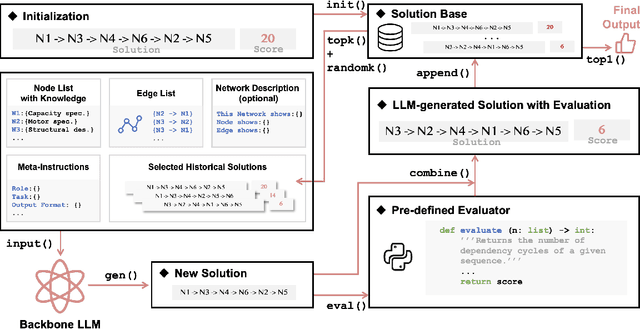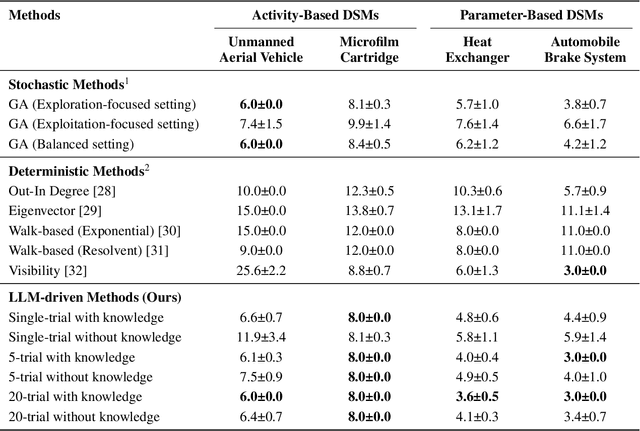Shuo Jiang
No Modality Left Behind: Adapting to Missing Modalities via Knowledge Distillation for Brain Tumor Segmentation
Sep 18, 2025



Abstract:Accurate brain tumor segmentation is essential for preoperative evaluation and personalized treatment. Multi-modal MRI is widely used due to its ability to capture complementary tumor features across different sequences. However, in clinical practice, missing modalities are common, limiting the robustness and generalizability of existing deep learning methods that rely on complete inputs, especially under non-dominant modality combinations. To address this, we propose AdaMM, a multi-modal brain tumor segmentation framework tailored for missing-modality scenarios, centered on knowledge distillation and composed of three synergistic modules. The Graph-guided Adaptive Refinement Module explicitly models semantic associations between generalizable and modality-specific features, enhancing adaptability to modality absence. The Bi-Bottleneck Distillation Module transfers structural and textural knowledge from teacher to student models via global style matching and adversarial feature alignment. The Lesion-Presence-Guided Reliability Module predicts prior probabilities of lesion types through an auxiliary classification task, effectively suppressing false positives under incomplete inputs. Extensive experiments on the BraTS 2018 and 2024 datasets demonstrate that AdaMM consistently outperforms existing methods, exhibiting superior segmentation accuracy and robustness, particularly in single-modality and weak-modality configurations. In addition, we conduct a systematic evaluation of six categories of missing-modality strategies, confirming the superiority of knowledge distillation and offering practical guidance for method selection and future research. Our source code is available at https://github.com/Quanato607/AdaMM.
Fin-PRM: A Domain-Specialized Process Reward Model for Financial Reasoning in Large Language Models
Aug 21, 2025Abstract:Process Reward Models (PRMs) have emerged as a promising framework for supervising intermediate reasoning in large language models (LLMs), yet existing PRMs are primarily trained on general or Science, Technology, Engineering, and Mathematics (STEM) domains and fall short in domain-specific contexts such as finance, where reasoning is more structured, symbolic, and sensitive to factual and regulatory correctness. We introduce \textbf{Fin-PRM}, a domain-specialized, trajectory-aware PRM tailored to evaluate intermediate reasoning steps in financial tasks. Fin-PRM integrates step-level and trajectory-level reward supervision, enabling fine-grained evaluation of reasoning traces aligned with financial logic. We apply Fin-PRM in both offline and online reward learning settings, supporting three key applications: (i) selecting high-quality reasoning trajectories for distillation-based supervised fine-tuning, (ii) providing dense process-level rewards for reinforcement learning, and (iii) guiding reward-informed Best-of-N inference at test time. Experimental results on financial reasoning benchmarks, including CFLUE and FinQA, demonstrate that Fin-PRM consistently outperforms general-purpose PRMs and strong domain baselines in trajectory selection quality. Downstream models trained with Fin-PRM yield substantial improvements with baselines, with gains of 12.9\% in supervised learning, 5.2\% in reinforcement learning, and 5.1\% in test-time performance. These findings highlight the value of domain-specialized reward modeling for aligning LLMs with expert-level financial reasoning. Our project resources will be available at https://github.com/aliyun/qwen-dianjin.
Bridging the Gap in Missing Modalities: Leveraging Knowledge Distillation and Style Matching for Brain Tumor Segmentation
Jul 30, 2025Abstract:Accurate and reliable brain tumor segmentation, particularly when dealing with missing modalities, remains a critical challenge in medical image analysis. Previous studies have not fully resolved the challenges of tumor boundary segmentation insensitivity and feature transfer in the absence of key imaging modalities. In this study, we introduce MST-KDNet, aimed at addressing these critical issues. Our model features Multi-Scale Transformer Knowledge Distillation to effectively capture attention weights at various resolutions, Dual-Mode Logit Distillation to improve the transfer of knowledge, and a Global Style Matching Module that integrates feature matching with adversarial learning. Comprehensive experiments conducted on the BraTS and FeTS 2024 datasets demonstrate that MST-KDNet surpasses current leading methods in both Dice and HD95 scores, particularly in conditions with substantial modality loss. Our approach shows exceptional robustness and generalization potential, making it a promising candidate for real-world clinical applications. Our source code is available at https://github.com/Quanato607/MST-KDNet.
* 11 pages, 2 figures
Large Language Models for Design Structure Matrix Optimization
Jun 11, 2025Abstract:In complex engineering systems, the interdependencies among components or development activities are often modeled and analyzed using Design Structure Matrix (DSM). Reorganizing elements within a DSM to minimize feedback loops and enhance modularity or process efficiency constitutes a challenging combinatorial optimization (CO) problem in engineering design and operations. As problem sizes increase and dependency networks become more intricate, traditional optimization methods that solely use mathematical heuristics often fail to capture the contextual nuances and struggle to deliver effective solutions. In this study, we explore the potential of Large Language Models (LLMs) for helping solve such CO problems by leveraging their capabilities for advanced reasoning and contextual understanding. We propose a novel LLM-based framework that integrates network topology with contextual domain knowledge for iterative optimization of DSM element sequencing - a common CO problem. Experiments on various DSM cases show that our method consistently achieves faster convergence and superior solution quality compared to both stochastic and deterministic baselines. Notably, we find that incorporating contextual domain knowledge significantly enhances optimization performance regardless of the chosen LLM backbone. These findings highlight the potential of LLMs to solve complex engineering CO problems by combining semantic and mathematical reasoning. This approach paves the way towards a new paradigm in LLM-based engineering design optimization.
Intelligent Design 4.0: Paradigm Evolution Toward the Agentic AI Era
Jun 11, 2025Abstract:Research and practice in Intelligent Design (ID) have significantly enhanced engineering innovation, efficiency, quality, and productivity over recent decades, fundamentally reshaping how engineering designers think, behave, and interact with design processes. The recent emergence of Foundation Models (FMs), particularly Large Language Models (LLMs), has demonstrated general knowledge-based reasoning capabilities, and open new paths and avenues for further transformation in engineering design. In this context, this paper introduces Intelligent Design 4.0 (ID 4.0) as an emerging paradigm empowered by agentic AI systems. We review the historical evolution of ID across four distinct stages: rule-based expert systems, task-specific machine learning models, large-scale foundation AI models, and the recent emerging paradigm of multi-agent collaboration. We propose a conceptual framework for ID 4.0 and discuss its potential to support end-to-end automation of engineering design processes through coordinated, autonomous multi-agent-based systems. Furthermore, we discuss future perspectives to enhance and fully realize ID 4.0's potential, including more complex design scenarios, more practical design implementations, novel agent coordination mechanisms, and autonomous design goal-setting with better human value alignment. In sum, these insights lay a foundation for advancing Intelligent Design toward greater adaptivity, autonomy, and effectiveness in addressing increasingly complex design challenges.
Towards Accurate and Interpretable Neuroblastoma Diagnosis via Contrastive Multi-scale Pathological Image Analysis
Apr 18, 2025



Abstract:Neuroblastoma, adrenal-derived, is among the most common pediatric solid malignancies, characterized by significant clinical heterogeneity. Timely and accurate pathological diagnosis from hematoxylin and eosin-stained whole slide images is critical for patient prognosis. However, current diagnostic practices primarily rely on subjective manual examination by pathologists, leading to inconsistent accuracy. Existing automated whole slide image classification methods encounter challenges such as poor interpretability, limited feature extraction capabilities, and high computational costs, restricting their practical clinical deployment. To overcome these limitations, we propose CMSwinKAN, a contrastive-learning-based multi-scale feature fusion model tailored for pathological image classification, which enhances the Swin Transformer architecture by integrating a Kernel Activation Network within its multilayer perceptron and classification head modules, significantly improving both interpretability and accuracy. By fusing multi-scale features and leveraging contrastive learning strategies, CMSwinKAN mimics clinicians' comprehensive approach, effectively capturing global and local tissue characteristics. Additionally, we introduce a heuristic soft voting mechanism guided by clinical insights to seamlessly bridge patch-level predictions to whole slide image-level classifications. We validate CMSwinKAN on the PpNTs dataset, which was collaboratively established with our partner hospital and the publicly accessible BreakHis dataset. Results demonstrate that CMSwinKAN performs better than existing state-of-the-art pathology-specific models pre-trained on large datasets. Our source code is available at https://github.com/JSLiam94/CMSwinKAN.
Kaiwu: A Multimodal Manipulation Dataset and Framework for Robot Learning and Human-Robot Interaction
Mar 07, 2025



Abstract:Cutting-edge robot learning techniques including foundation models and imitation learning from humans all pose huge demands on large-scale and high-quality datasets which constitute one of the bottleneck in the general intelligent robot fields. This paper presents the Kaiwu multimodal dataset to address the missing real-world synchronized multimodal data problems in the sophisticated assembling scenario,especially with dynamics information and its fine-grained labelling. The dataset first provides an integration of human,environment and robot data collection framework with 20 subjects and 30 interaction objects resulting in totally 11,664 instances of integrated actions. For each of the demonstration,hand motions,operation pressures,sounds of the assembling process,multi-view videos, high-precision motion capture information,eye gaze with first-person videos,electromyography signals are all recorded. Fine-grained multi-level annotation based on absolute timestamp,and semantic segmentation labelling are performed. Kaiwu dataset aims to facilitate robot learning,dexterous manipulation,human intention investigation and human-robot collaboration research.
XLSTM-HVED: Cross-Modal Brain Tumor Segmentation and MRI Reconstruction Method Using Vision XLSTM and Heteromodal Variational Encoder-Decoder
Dec 09, 2024



Abstract:Neurogliomas are among the most aggressive forms of cancer, presenting considerable challenges in both treatment and monitoring due to their unpredictable biological behavior. Magnetic resonance imaging (MRI) is currently the preferred method for diagnosing and monitoring gliomas. However, the lack of specific imaging techniques often compromises the accuracy of tumor segmentation during the imaging process. To address this issue, we introduce the XLSTM-HVED model. This model integrates a hetero-modal encoder-decoder framework with the Vision XLSTM module to reconstruct missing MRI modalities. By deeply fusing spatial and temporal features, it enhances tumor segmentation performance. The key innovation of our approach is the Self-Attention Variational Encoder (SAVE) module, which improves the integration of modal features. Additionally, it optimizes the interaction of features between segmentation and reconstruction tasks through the Squeeze-Fusion-Excitation Cross Awareness (SFECA) module. Our experiments using the BraTS 2024 dataset demonstrate that our model significantly outperforms existing advanced methods in handling cases where modalities are missing. Our source code is available at https://github.com/Quanato607/XLSTM-HVED.
Large Language Models for Combinatorial Optimization of Design Structure Matrix
Nov 19, 2024



Abstract:Combinatorial optimization (CO) is essential for improving efficiency and performance in engineering applications. As complexity increases with larger problem sizes and more intricate dependencies, identifying the optimal solution become challenging. When it comes to real-world engineering problems, algorithms based on pure mathematical reasoning are limited and incapable to capture the contextual nuances necessary for optimization. This study explores the potential of Large Language Models (LLMs) in solving engineering CO problems by leveraging their reasoning power and contextual knowledge. We propose a novel LLM-based framework that integrates network topology and domain knowledge to optimize the sequencing of Design Structure Matrix (DSM)-a common CO problem. Our experiments on various DSM cases demonstrate that the proposed method achieves faster convergence and higher solution quality than benchmark methods. Moreover, results show that incorporating contextual domain knowledge significantly improves performance despite the choice of LLMs. These findings highlight the potential of LLMs in tackling complex real-world CO problems by combining semantic and mathematical reasoning. This approach paves the way for a new paradigm in in real-world combinatorial optimization.
Flipping-based Policy for Chance-Constrained Markov Decision Processes
Oct 09, 2024Abstract:Safe reinforcement learning (RL) is a promising approach for many real-world decision-making problems where ensuring safety is a critical necessity. In safe RL research, while expected cumulative safety constraints (ECSCs) are typically the first choices, chance constraints are often more pragmatic for incorporating safety under uncertainties. This paper proposes a \textit{flipping-based policy} for Chance-Constrained Markov Decision Processes (CCMDPs). The flipping-based policy selects the next action by tossing a potentially distorted coin between two action candidates. The probability of the flip and the two action candidates vary depending on the state. We establish a Bellman equation for CCMDPs and further prove the existence of a flipping-based policy within the optimal solution sets. Since solving the problem with joint chance constraints is challenging in practice, we then prove that joint chance constraints can be approximated into Expected Cumulative Safety Constraints (ECSCs) and that there exists a flipping-based policy in the optimal solution sets for constrained MDPs with ECSCs. As a specific instance of practical implementations, we present a framework for adapting constrained policy optimization to train a flipping-based policy. This framework can be applied to other safe RL algorithms. We demonstrate that the flipping-based policy can improve the performance of the existing safe RL algorithms under the same limits of safety constraints on Safety Gym benchmarks.
 Add to Chrome
Add to Chrome Add to Firefox
Add to Firefox Add to Edge
Add to Edge